The 2013 International Production and Processing Expo (IPPE) once again gave feed industry professionals a bird's eye view of today's most pressing issues, opportunities and challenges facing the industry. Providing that information was the American Feed Industry Association, the sponsor of the International Feed Expo, one of the three shows co-located at IPPE 2013.
AFIA presented educational programs including the International Feed Industry Institute and the annual Pet Food Conference as well as the Feed Education Forum, a half-day forum addressing issues unique to feed manufacturers in three knowledgeable sessions.
The forum opened with an update from Keith Epperson, AFIA’s vice president of manufacturing and training, on the latest regulations from the U.S. Environmental Protection Agency (EPA) and the Occupational Safety and Health Administration (OSHA).
Richard Sellers, vice president of nutrition and feed regulation, gave an update on the Food Safety Modernization Act (FSMA) and other government compliance rules including the Farm Bill, Salmonella, the ethoxyquin rule and inspection tips.
Sellers expects the feed rules of the FSMA to be published by mid-February 2013 and noted that facilities participating in the AFIA’s Safe Feed/Safe Food Certification Program should already be compliant with the regulation.
In addition to the educational programs available to all IPPE attendees, several AFIA leaders stopped by Feed & Grain's booth to share their insights on what the future holds for the feed industry.
Safe Feed/Safe Food Certification Program = FSMA compliance
Since launching them at the 2012 International Feed Expo, Epperson revealed that both of AFIA's Pet Food Safe Feed/Safe Food Certification Programs have been well received by the industry and four are certified with a number of others in the process of being audited.
"The FDA looks at these programs favorably and ... with third party certification being a key requirement of the FSMA, we see potential certification for our members through the program," Epperson said.
Another program growing in popularity is the International Safe Feed/Safe Food program, which partners with FEFANA, the European association for the producers of specialty feed ingredients and their mixtures.
"The international program began two years ago and we have almost 20 certified facilities with two more in the process," said Epperson.
The domestic program is the foundation Safe Feed/Safe Food Certification Program and the AFIA certified its first facility in 2005.
"Today there are 470 facilities certified facilities representing just over 100 companies because many companies have multiple facilities certified," Epperson said. "The benefits of enrolling in the Safe Feed/Safe Food Certification Program are that it brings quality and food safety to a new level. Certified facilities see a safer product go out the door because they’re meeting and exceeding the FDA guidelines."
To watch the complete interview with Epperson, enter search ID 10861081.
World population, commodity prices, weather pose challenges
"Feeding a population of 9.1 billion people by the year 2050 is a huge undertaking by the industry, but one that I think we can achieve on a global basis," expressed Joel Newman, president and CEO of AFIA.
To meet this challenge, Newman said the AFIA established a sustainability initiative two years ago which focuses on six key points and relies on a special committee to discuss and make recommendations for addressing those issues.
In addition to feeding an exploding population, high commodity prices and market volatility are two trends Newman predicted will extend into 2013. Companies in the feed industry will benefit from solid risk managements plans because "as we go into spring, we’re all hoping for a successful planting season, but we need to recognize we’re still in a drought condition," Newman said. "The open question is how will spring planting go and will we have enough moisture to produce a good crop."
Newman also highlighted some bright spots the feed industry has to look forward to.
"With every challenge comes an opportunity," Newman said. "The increased global demand for food provides us with not only the opportunity to feed the U.S. population but to export some of our production to other parts of the world, both animal protein products and our feed technology and additives, allowing them to increase their own production."
To watch the complete interview with Newman, enter Search ID: 10861706.
IFEEDER celebrates anniversary
In 2009, the Institute for Feed Education and Research (IFEEDER) was formed to support the future of the feed industry as it works to sustain the escalating world population. It was launched at the 2010 International Feed Expo and on Jan. 29, IFEEDER hosted a luncheon to commemorate the anniversary and seek assistance from leading companies throughout the feed industry. The charitable foundation has already surpassed $1.2 million in pledges and is on the way to reaching its three-year goal of $2 million.
Dean Warras, chairman of IFEEDER's board of trustees, explained that there are plenty reasons why everyone in the feed industry should be concerned with IFEEDER's mission.
"As we look forward to 2050, we’re going to have approximately 9.1 billion people in the world, and so our focus is how are we going to feed them," Warras said. "We can do that by making a more sustainable U.S. feed and food production industry."
IFEEDER supports creating a more sustainable U.S. feed industry in a number of ways, as outlined by Jim Sullivan, executive director of IFEEDER.
"We’ve funded a number of educational efforts in different forms," Sullivan said. "We offer scholarships to graduate students for programs like the feed industry institute, and we provide funding for research on the sustainability of the feed ingredients used in the world and studies on the use of byproducts in the feed industry and their ramifications."
To watch the complete interview with Warras and Sullivan, enter Search ID: 10861069
Read more IPPE highlights, interviews with equipment manufacturers and service providers, and show news at www.feedandgrain.com/ippe.



















